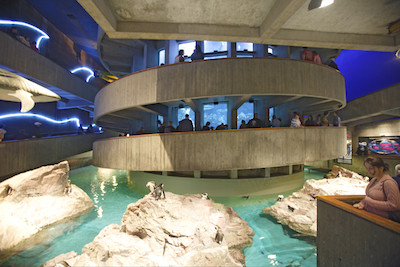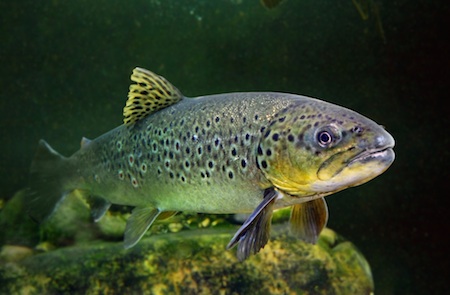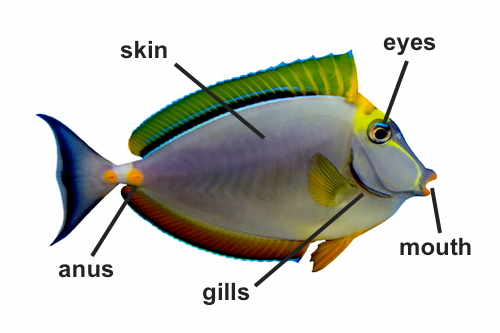
Chapter 20. Some Fish Conform, Others Regulate
Some Fish Conform, Others Regulate

Read the article below. Then answer the questions that follow.
On July 1, 2013, the four-story Giant Ocean Tank at Boston’s New England Aquarium reopened after a 10-month, $17.3 million renovation. The massive overhaul completely transformed the 200,000-gallon tank, allowing it to now hold more than 2,000 marine animals and nearly 130 different species.

Although the Giant Ocean Tank is the big attraction at the aquarium, exhibits like the Amazon River Tank, which feature freshwater organisms, also are a draw for the facility’s more than 1.3 million visitors each year. Observing the variety of aquatic life on display, it is easy to ponder why some organisms are able to live in the salty waters of the Giant Ocean Tank while other creatures can survive only in freshwater exhibits, and vice versa.
Some aquatic animals lack the ability to regulate the concentration of solutes in their bodily fluids. These organisms, which include aquatic invertebrates, maintain an internal concentration of solutes, or dissolved compounds, that are the same as the water they inhabit. They are called osmoconformers.
However, most aquatic animals, including bony vertebrates, have the ability to regulate the concentration of solutes within their bodily fluids, regardless of their surrounding environment. These organisms are called osmoregulators.
Osmoregulators living in marine environments face a challenge, though: they can dehydrate easily. This is because water always moves across a semipermeable membrane from a region of lower solute concentration (and higher water concentration) to a region of higher solute concentration (and lower water concentration) in a process called osmosis.
Marine dwellers living in the Giant Ocean Tank, for instance, have a lower solute concentration within their bodily fluids compared to the super-salty surrounding water. Therefore, water naturally diffuses out of their hypotonic bodily fluids and into the hypertonic seawater environment.
Water is constantly moving out of marine fish, primary through their gills, but also through other permeable body surfaces. In turn, these fish have evolved remarkable, but simple, strategies to keep from drying out. For one, they drink a lot of seawater. But as a consequence, they also take in a large amount of salt. Using Adenosine Triphosphate (ATP) as an energy source, their gills have the ability to actively pump salt out of their bodies. Additionally, their kidneys produce very small amounts of ultra-concentrated urine.
Osmoregulators living in fresh water have the opposite problem. Their bodily fluids have a higher internal solute concentration compared to their external, hypotonic freshwater environment. As a result, water is constantly moving by osmosis into their gills and other permeable body surfaces. At the same time, salt is moving out of their bodies by diffusion. Ultimately, these osmoregulators balance the amounts of water and solutes in their systems by producing large volumes of dilute urine. They also reabsorb salt that has diffused out of their cell membranes by actively pumping it back into their gills.
‘Breathing’ under water
No matter where they live, fish must exchange gases in order to stay alive; oxygen must enter their body tissues, and carbon dioxide must exit.

Saltwater fish drink water as they swim. Any water that isn’t ingested flows over the gills and out through the gill cover, or operculum. As water passes over the gills, oxygen diffuses from the water (the area of higher oxygen concentration) through the membranes and into the blood of the highly vascularized gill tissue (the area of lower oxygen concentration). Because the gills have a large surface area, a large percentage of the oxygen is absorbed directly through the gill tissue. At the same time, blood flowing through the gills contains a higher concentration of carbon dioxide than the surrounding water. Consequently, as blood flows through the gills, carbon dioxide diffuses out of the gills and into the surrounding water.
By comparison, freshwater fish do not “breathe” by drinking water. This is because water is constantly diffusing by osmosis into their hypertonic tissues, either directly through the gills or through other permeable body surfaces. The system of gas exchange, however, essentially is the same: as water flows over the vascularized tissue, oxygen diffuses into the bloodstream and carbon dioxide diffuses out.
© 2015 WH Freeman and Company.
20.1 Comprehension Questions
Answer the following questions to demonstrate your understanding of the article.
1.
Fill in the Missing Term:
, maintain an internal concentration of solutes that are the same as the water they inhabit.
2.
True/False:
Marine fish produce a lot of urine because their cells contain a greater concentration of solute than the surrounding water.
3.
Click the label in the diagram below that correctly completes the following sentence:
In marine fish, water is constantly moving out of the ______.
4.
Fill in the Missing Term:
Freshwater fish produce large amounts of urine.
5.
Fill in the Blank:
A cell’s cytoplasm would be classified as a(n) solution if it contains a greater concentration of solute than the fluid surrounding the cell.
6.
Which statement below best describes the osmotic movement of water through the gills of fish living in marine environments?
| A. |
| B. |
| C. |
| D. |
| E. |
7.
Which of the following best describes how a fish breathes when swimming through water?
| A. |
| B. |
| C. |
| D. |
| E. |
8.
Your town has proposed an ordinance that seeks to restrict use of salt on roads near local lakes and waterways. In terms of how salty runoff might affect fish, why might this ordinance be a good idea?
| A. |
| B. |
| C. |
| D. |
| E. |
9.
Considering the energetic demands placed on the gills of marine fish, which organelle below would you expect to find in large numbers in gill cells? (Click on the correct organelle.)
{"title":"Smooth ER","description":"No. The Smooth ER synthesizes lipids and detoxifies molecules. Hint: which organelle is involved in harvesting energy?","type":"incorrect","color":"#ffff99","code":"[{\"shape\":\"rect\",\"coords\":\"3,5,83,106\"}]"} {"title":"Lysosomes","description":"No. Lysosomes digest and recycle cellular waste. Hint: which organelle is involved in harvesting energy?","type":"incorrect","color":"#ffff99","code":"[{\"shape\":\"rect\",\"coords\":\"207,7,292,108\"}]"} {"title":"Golgi apparatus","description":"No. The Golgi apparatus processes and packages proteins, lipids, and other molecules. Hint: which organelle is involved in harvesting energy?","type":"incorrect","color":"#ffff99","code":"[{\"shape\":\"rect\",\"coords\":\"310,8,395,109\"}]"} {"title":"Rough ER","description":"No. The Rough ER modifies proteins that are to be shipped elsewhere within an organism. Hint: which organelle is involved in harvesting energy?","type":"incorrect","color":"#ffff99","code":"[{\"shape\":\"rect\",\"coords\":\"409,9,494,110\"}]"} {"title":"Mitochondria","description":"Yes! Mitochondria produce ATP, which is used as the energy source for actively pumping salt out of the gills. This mechanism, along with normal kidney metabolism, helps marine fish maintain a hypotonic environment within its bodily fluids despite living in a hypertonic marine environment.","type":"correct","color":"#ffff99","code":"[{\"shape\":\"rect\",\"coords\":\"91,8,196,107\"}]"}10.
Your friend catches some small fish from the ocean and brings them home to put in his freshwater aquarium. The next day, he finds all of the ocean fish floating on the surface of the water. Why did the fish die?
| A. |
| B. |
| C. |
| D. |
| E. |
Activity results are being submitted...

